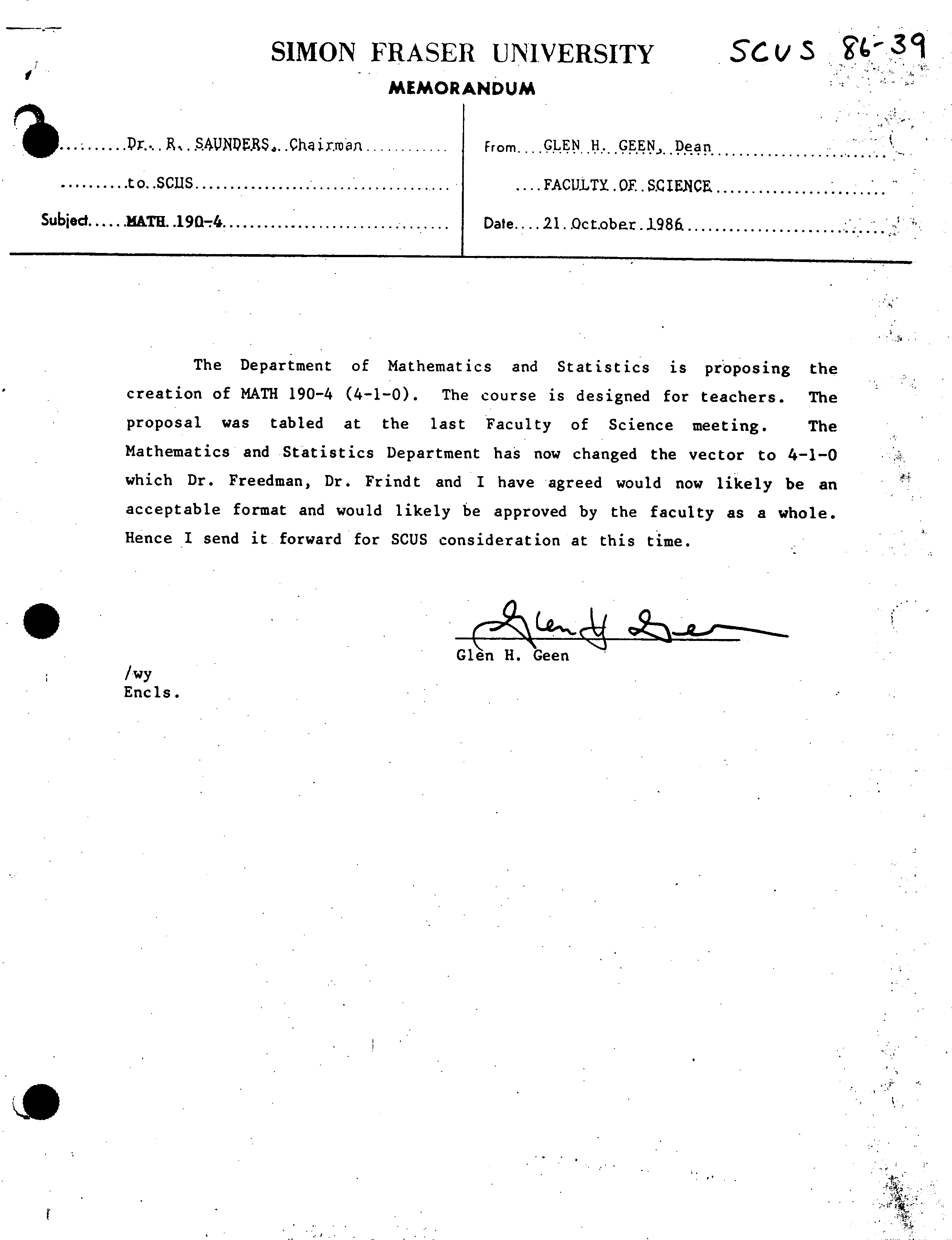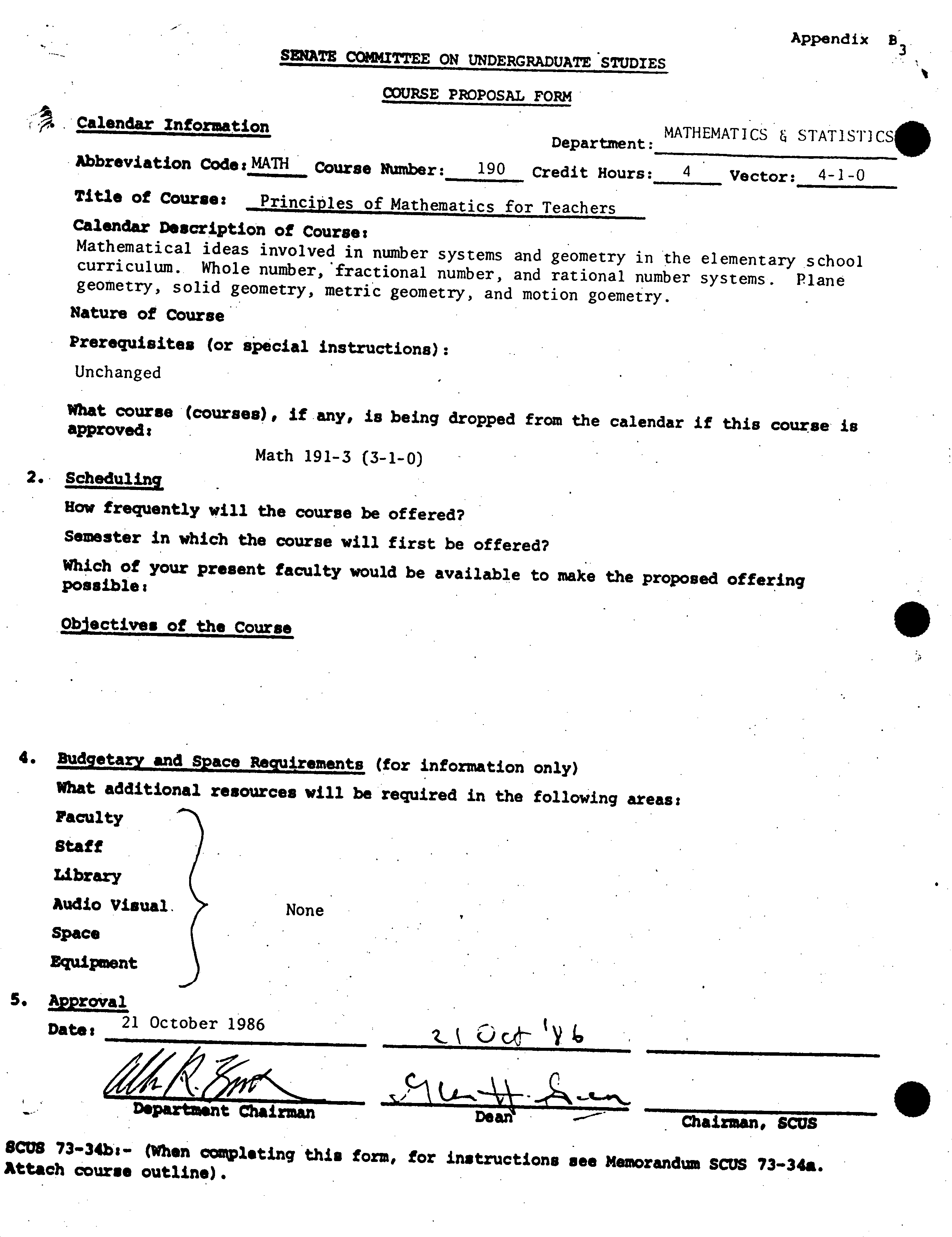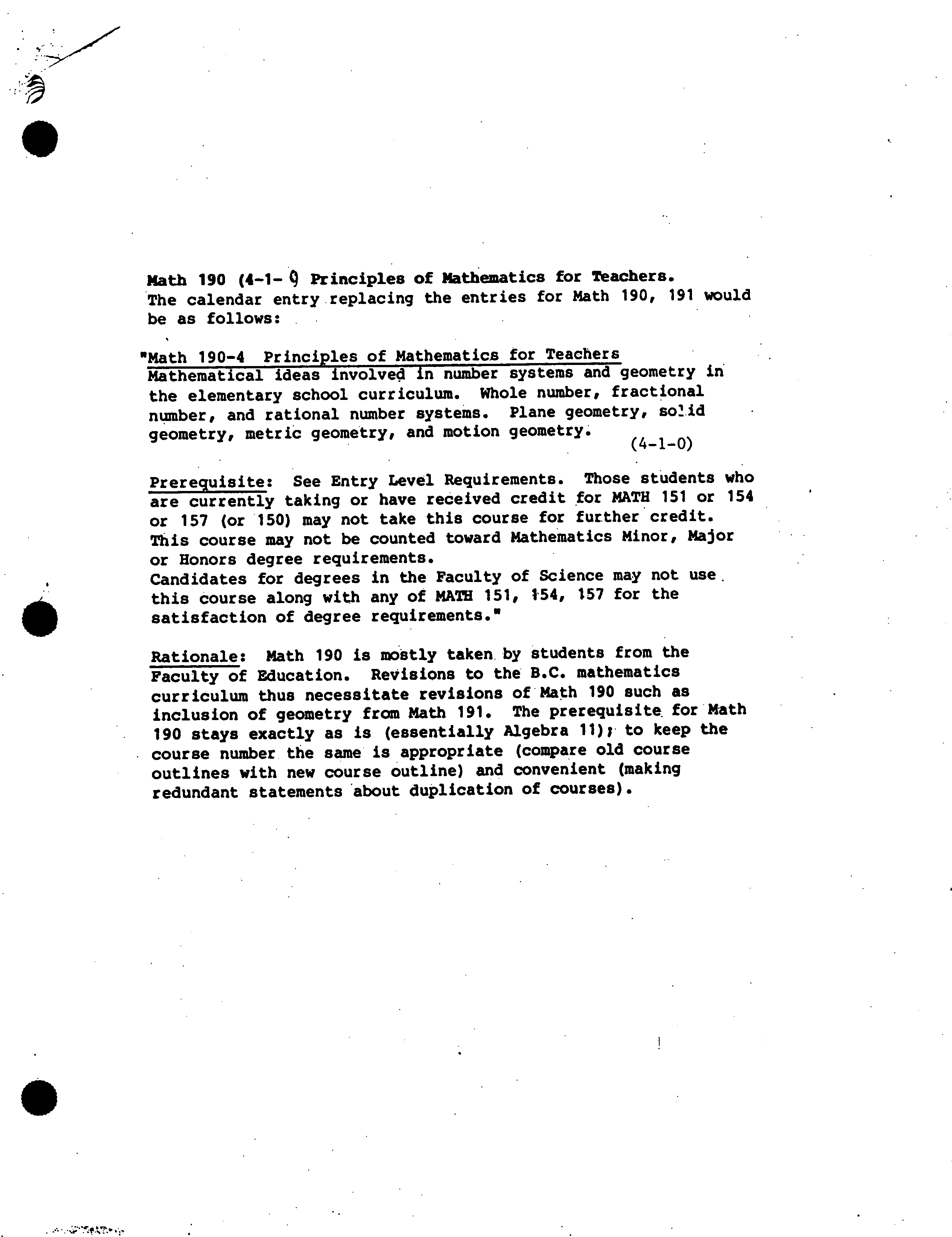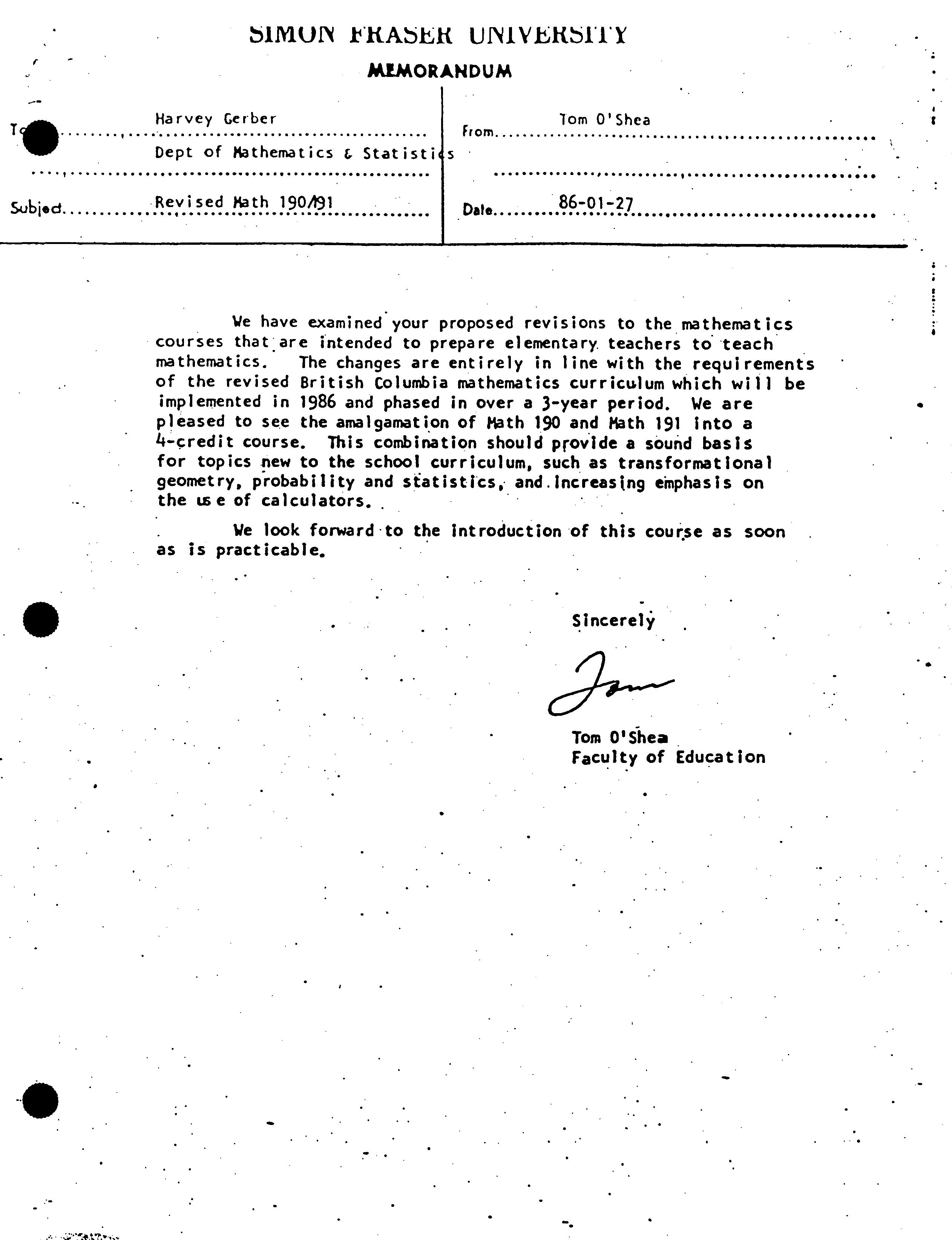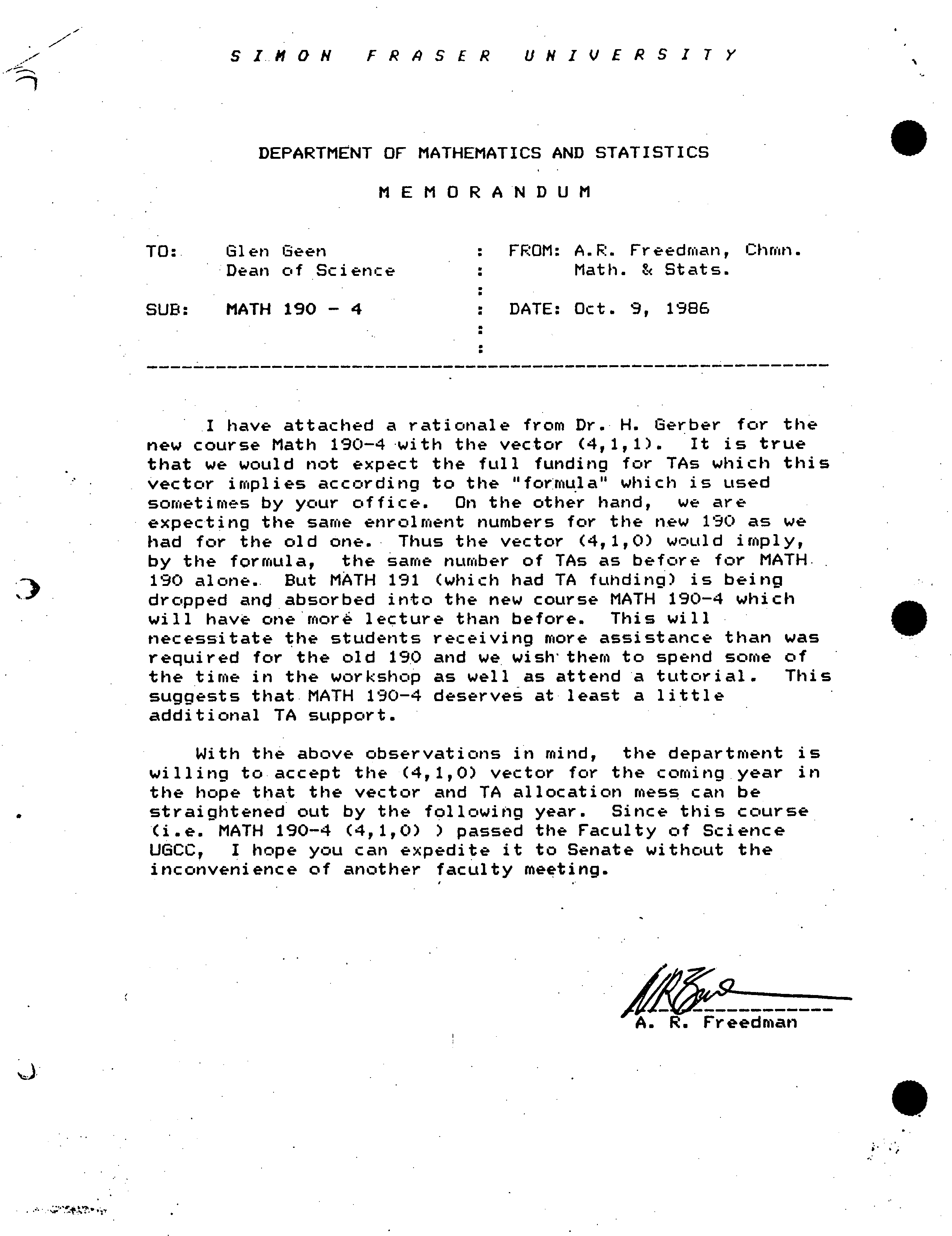.
SIMON
FRASER UNIVERSITY
MEMORANDUM
To: Senate
From: Senate Committee on
Undergraduate Studies
Subject:
Department of Mathematics
Date:
November 12, 1986
and Statistics - New Course
Action undertaken by the Senate Committee on Undergraduate Studies at its meeting of
October 21, 1986 gives rise to the following motion:
MOTION:
That Senate approve and recommend approval to the Board of Governors
as set forth in S.86- 791, the proposal to combine the following two courses:
MATH 190-3
Principles of Mathematics for Teachers I; and
MATH 191-3
Principles of Mathematics for Teachers II
into one new course
.
MATH 190-4
Principles of Mathematics for Teachers."
0
.to. .SCUS
.
Subje.. .19Q4
.
SCti S
31.
From
.Pe.an
FACULTY .
OF..
S.CIEiW ...........................
Date....2l..Oct.obr.j98
.......................
SiMON FRASER UNIVERSITY
MEMORANDUM
The Department of Mathematics and Statistics is proposing the
creation of MATH 190-4 (4-1-0). The course is designed for teachers. The
proposal was tabled at the last Faculty of Science meeting. The
Mathematics and Statistics Department has now changed the vector to 4-1-0
which Dr. Freedman, Dr. Frindt and I have agreed would now likely
be an
acceptable format and would likely be approved by the faculty as a whole.
Hence I send it forward for SCUS consideration at this time
• __________
Glen H.
Geen
•
/wy
Ends.
..
SATE CO*IIL
V
PEE ON UNDERGRADUATE STUDIES
Appendix B3.
COURSE
P
RO
POSAL FORM
MATHEMATICS _STAT1ST)CS
Department:______________________
Abbreviation Code; MATH Course Number:
190 Credit
flours: 4
Vector:
41-0
Title of Course:
Principlesof Mathematics for Teachers
Calendar Description of Course;
Mathematical ideas involved in number systems and geometry in the elementary school
curriculum. Whole number, fractionai number, and rational number systems. Plane
geometry, solid geometry, metric geometry, and motion goemetry.
Nature of Course
Prerequisites (or special instructions):
Unchanged
What course (courses), if any, is being dropped from the calendar if this course is
approved:
Math 191-3 (3-1-0)
2.
Scheduling
How frequently will the course be offered?
Semester in which the course will first be offered?
Which of your present faculty would be available to make the proposed offering
possible;
O bjectiv es of the Course
4.
Budgetaryand Space
Req
uirements (for information only)
What additional resources will be required in the following areas:
Faculty
Staff
Library
Audio Visual.
None
Space
Equipment
S
S.
approval
Dates
21 October 1986
Dspartmj
nt chairman
Dean
Chairman, SCUS
SCUS 73-34b'- (When conpl.ting this form, for instructions see Memorandum SCUS 73-34*.
Attach course outline).
'p.. Calendar Information
Math 190 (4-1- q Principles of Mathematics for Teachers.
The calendar entry replacing the entries for Math 190, 191 would
be as follows:
"Math 190-4 Principles of Mathematics for Teachers
Mathematical ideas involved in number systems and geometry in
the elementary school curriculum. Whole number, fractional
number, and rational number systems. Plane geometry, solid
geometry, metric geometry, and motion geometry.
4-1-0
Prerequisite: See Entry Level Requirements. Those students who
are currently taking or have received credit for MATH 151 or 154
or 157 (or 150) may not take this course for further credit.
This course may not be counted toward Mathematics Minor, Major
or Honors degree requirements.
Candidates for degrees in the Faculty of Science may not use.
.
this course along with any of MATH 151, 154, 157 for the
satisfaction of degree requirements.
Rationale: Math 190 is mostly taken. by students from the
Faculty of Education. Revisions to the B.C. mathematics
curriculum thus necessitate revisions of Math 190 such as
inclusion of geometry from Math 191. The prerequisite for Math
190 stays exactly as is (essentially Algebra 11); to keep the
course number the same is appropriate (compare old course
outlines with new course outline) and convenient (making
redundant statements about duplication of courses).
fl
-
Hours
1
Sets whole numbers and counting nurnber.
2.
1
Addition of whole numbers
22
1
Multiplication of whole numbers
2.3
1
Hand calculators and flow charts
3. 1
1
Subtraction of whole numbers
3.2
1
Division of
whole numbers S
4. 1
1
Expi:tnents
4.2
2.0
Factorization and primes
5.1
1
.
Fractional numbers
5.2
.
1
Equivalence of fractions
5.3
1.5
Simplest form and greatest common factors
5.4
1
Addition and subtraction of fractional numbers
5.5
1
Least •:orm
' : ' n denominators & least common multiples
5.6
.0.5
Multiplication an
.
d division of fractional numbers
6.1
1
Decimal
fractions - addition & subtraction
6.2
1
Multiplication and division of. decimals
6.3
1
Repeating decimals
6.4
.2.0
Percent
.
6.5
2.0
. Applications of percents
7.1
1
•.
Addition of integers and rationals
7.2
1
. .
Subtraction of integers and rationals
7.3
1 .
Multiplication and division o
,
f integers & rationals
74
1 . .
Negative exponents and scientific notation
9
.
. 1
2.0 .
Points,
lines and planes
9.2
.
1
Length and the metric system
9.3
.1
Separation
9.4
1
Angles and angle measurement
1
Simple closed curves and polygons
10.1
.
1.5
. Areas
10.2
1
,. Polyhedrons and surface areas
10.3
1
Volume
. .
.
10.4
0.5
.
Circles,
cylinders, cones and spheres
11.1
1
Flips
.
. .
11.2
1
.
.
Slides
11.3
1
Turns .
.
11.4
1
More on angles
.
12.1
2.0
Congruence of triangles
13.1
1
..
.
Functions
.
. .
13.2
1
. Graphs
14.1
1
Probability
.
14.2
1
Statistics-
Prere
q
uisite: B.C. High School Algebra 11 (or equivalent). Students lacking
this background may take.the non-credit Basic Math Course offered through
Continuing Studies, A06050. Students with a grade of P. in B.C. High School
Algebra 11 should take the Math Assessment Test. Those students who are
currently taking or have received credit for MATH 151-3 or MATH 154-3 or MATH
157-3 (MATH 150-3) may not take this course for further credi
1 t. This course
may not be counted towards Mathematics Minor, Major
or Honors degree
requirements. Candidates for- degrees in the Faculty of Science may not use
course for the satisfaction of
degree requirements.
Tetbook: MATHEMATICS FOR ELEMENTARY SCHOOL TEACHERS,, by H. Gerber,
published by C.B.S. College Publishers
S
S
S
•
1MUIN FKA5F.1( UfNIV1Kb1I
MEMORANDUM
r
e
Harvey
Ha
Gerber
Tom
O'Shea
T.
............. ..............................
From.......................................................
Dept of Mathematics
C. Staisti
s
.........................................................
Subjeä ............
.....e .
.
d
Ma 10A91
9
....
.
Date
.........
.
86-01-2.
........
We have examined your proposed revisions to the mathematics
courses thatare intended to prepare elementary. teachers to teach
mathematics.
The changes are entirely in line with the requirements
of the revised British Columbia mathematics curriculum which will be
implemented in 1986 and phased in over a 3-year period. We are
pleased to see the amalgamation of Math
190
and Math 191 Into a
•
4-credit course. This combination should
provide
a so 'un
'
d basis
for topics new to the school curriculum, such as transformational
geometry, probability and statistics, and-increasing emphasis on
the ise of calculators.
We look forward to the Introduction of this course as soon
as is practicable.
•
•
.
Sincerely
Tom O'Shea
• .
•
•
Faculty of Education
SIMON FRQSER UNIVERSITY
DEPARTMENT OF MATHEMATICS AND STATISTICS
MEMORANDUM
TO: Glen Seen
: FROM: A.R. Freedman, Chriin.
Dean of Science
:
Math. & Stats.
SUB:
MATH 190 - 4
:
DATE: Oct.
9,
1986
I have attached a rationale from Dr. H. Gerber for the
new course Math 190-4 with the vector (4,1,1). It is true
that we would not expect the full funding for TAs which this
•
vector implies according to the "formula" which is used
sometimes by your office. On the other hand, we are
•
expecting the sarie enrolment numbers for the new 190 as we
had for the old one. Thus the vector (4,1,0) would imply,
by the formula, the same number of TAs as before for MATH.
190 alone.. But MATH 191 (which had TA fuhding) is being
dropped and absorbed into the new course MATH 190-4 which
will have one more lecture than before. This will
necessitate the students receiving more assistance than was
required for the old 19
.
0 and we wish them to spend some of
•
the time in the workshop as well as attend a tutorial. This
suggests that MATH 190-4 deserves at least a little
additional TA support.
With the above observations in mind, the department is
willin g
to accept the (4,1,0) vector for the coming year in
the hope that the vector and TA allocation mess can be
straightened out by the following year. Since this course
(i.e. MATH 190-4 (4
1
1,0) ) passed the Faculty of Science
UGCC, I hope you can expedite it to Senate without the
inconvenience of another faculty meeting.
A
-
R.reedman
S
• p
•
.,
•
S I H 0 H F R Q S E P U N I V E P S I T Y
DEPARTMENT OF MATHEMATICS AND STATISTICS
MEMORANDUM
TO: Dr. G.H. Geen
: FROM: H. Gerber
Dean of Science
:
Math. & Stats.
SUB: MATH
190
:
DATE: 8 October 1986
Dr. Allen Freedriañ thought that you might be
interested in why we want tochange Math 190-3,
Principles
of Mathematics for Elementary School Teachers I
frorui a 3
• credit course
to a 4 credit course, and thereby remove from
•
the calendar offering Math 191-3
Princi p
les of Mathematics
for Elementar y
School Teachers 11.
Before enumeratin g
these
reasons, I should state that the suggestion we change the
present Math 190-3 course came from the Faculty of
•
Education, in particular from Dr. Toni O'Shea. The
curriculum of the proposed Math 190-4 course was formulated
with the help of Prof. O'Shea.
The reasons for changing the current 3 credit
course to a 4 credit course are as follows:
1)
Because of the proposed changes to the elementary
school curriculum, the material on geometry which is in Math
191-3 should be available to all of prospective elementary
school teachers. Since Math 191-3 is not required by the
Education Faculty, that material should appear in Math 190-
3.
2)
Some of the material onthe arithmetic algorithms
which we propose to remove from Math 190-3 to make room for
goeriietry, statistics, and probability, is currently taught
in one of the Faculty of Education's methods courses.
Moreover, this same material is being downgraded in the
proposed changes to the elementary school curriculum.
• 3) The changin
g
from a 3 credit to a 4 credit course
will cause the Faculty of Education no difficulty
since most
of their offerings
are
4 credit courses.
4) You will observe that with the proposed change the
Mathematics and Statistics Department will
be teaching 190-4
Cl
three times a year, for a total of 12 hours. At present we
teach Math 190-3 three times a year and Math 191-3 once a
year, for a total.
again
of 12 hours. In short, there will
be no increase in our Department's load with the proposed
change.
The reasons for wanting to use the vector (4-1-1)
are also simple to state:
1)
The use of both a tutorial and the workshop was
tried by Dr. Bernice Kastner one semester and was found to
be vastly superior
,
to the use of only the workshop.
2)
The students in Math 190-3 currently spend, on the
average, 4-6 hours a week working in the workshop. The
workshop mainly serves only one aspect of the course - to
try to find and describe mathematical patterns. The
homework problems assigned take hours of work. The students
use the workshop primarily to solve these problems. The
other aspect of the course, to explain why the processes of
elementary mathematics work, is best handled in a tutorial
setting.
3)
Finally, with the addition of an extra hour of
class the workload becomes extremely difficult to handle
without the extra help that the tutorial would provide.
If you want to see a more detailed description of
the changes, I will be pleased to submit it.
H... Gerber
HG/bc 1


